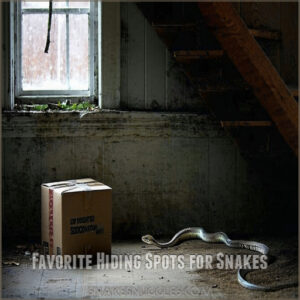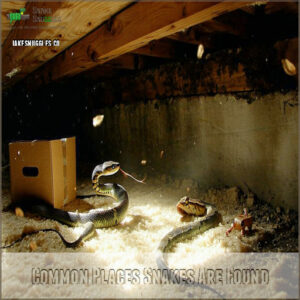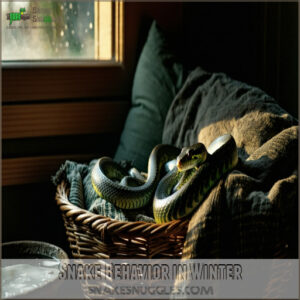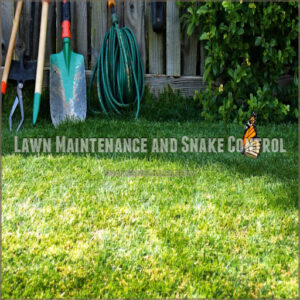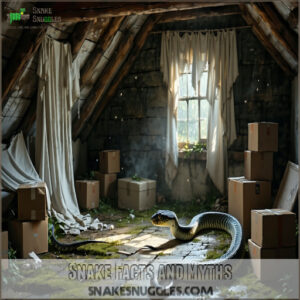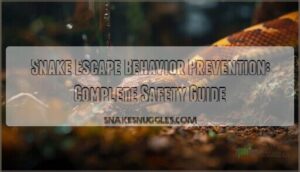This site is supported by our readers. We may earn a commission, at no cost to you, if you purchase through links.

And yes, they might choose your house as their winter getaway, preferring places with stable temperatures, water sources, or even a nice rodent buffet.
They’re not there to scare you; they’re just trying to survive, sneaking into warm, cozy spots like basements, crawl spaces, attics, or even walls to escape freezing temperatures.
Keeping your house sealed and clutter-free can help prevent these uninvited guests.
Curious about why they pick specific spots or how to keep them out? Let’s explore more.
Table Of Contents
- Key Takeaways
- Snakes in Winter: Do They Hibernate in Houses?
- Where Do Snakes Hide in The House?
- What Attracts Snakes to Your House?
- Snake Behavior in Winter
- Preventing Snake Infestations
- Snake Removal: What to Do
- Snake Facts and Myths
- Frequently Asked Questions (FAQs)
- Can snakes hibernate inside a house?
- Do snakes hibernate in the winter?
- What is snake hibernation?
- Where do snakes go in winter?
- Are snakes more likely to enter homes in winter?
- Do pythons hibernate?
- Will snakes come in your house in the winter?
- How long will a snake stay in your house?
- How do you know if a snake is living in your house?
- Where would snakes hide in a house?
- Conclusion
Key Takeaways
- Snakes don’t truly hibernate but enter brumation, a state where they slow down to survive cold temperatures.
- They might sneak into basements, crawl spaces, or attics in houses, seeking warmth, moisture, and food sources.
- Signs of snakes in your home include shed skin, tubular droppings, slithering noises, and disturbances in dark corners or storage areas.
- To prevent them, seal entry points, clear clutter, and manage food sources like rodents that can attract snakes.
Snakes in Winter: Do They Hibernate in Houses?
When winter hits, snakes slow down and enter brumation to survive the cold. Sometimes, they might sneak into houses, finding warmth and shelter in basements or crawl spaces.
What is Brumation?
Ever notice how snakes seem to vanish in the winter?
They’re not hibernating like bears but entering brumation—a state cold-blooded animals use to tackle tough winters.
The brumation process slows their heartbeat, breathing, and metabolism, saving energy when temperatures drop.
Their body temperature matches their surroundings, and while they look dormant, they’re still alert enough to react if needed.
This winter dormancy in reptiles isn’t true hibernation but rather a period of reduced activity.
Think of it as nature’s energy-saving mode for winter survival.
This clever reptile behavior helps them survive harsh conditions without eating much.
Snake physiology is fascinating, huh?
A survival masterclass, all thanks to brumation!
How Long Do Snakes Brumate?
Snakes don’t truly hibernate, but their brumation periods can last anywhere from a couple of months to most of the year, depending on the species and climate.
In colder places, wintering snakes may stay tucked away in their hibernaculum from September to April, while in warmer areas, their dormancy might only stretch for 2-3 months.
Snakes brumate to prepare for breeding, as detailed in this snake brumation guide.
The survival trick here is energy conservation.
Snakes slow their metabolic engines way down, only stepping out of their cozy spots when temperatures hit around 60°F (15°C).
It’s a bit like a snake-sized snooze button—just enough movement to grab water during mild weather spells.
Here’s what to know about the brumation period:
- Colder climates, longer brumation; warmer areas, shorter naps.
- Species like garter snakes may brumate in groups for shared body warmth.
- Signs of dormant snakes include sluggishness and shed skin nearby.
- Snakes in homes might appear in basements on warmer winter days.
Where Do Snakes Hide in The House?
Snakes can be surprisingly good at finding hidden spots inside your house, especially during colder months when they’re seeking warmth.
They might settle under your porch, inside your attic, or even behind appliances like a fridge, staying quiet and out of sight in warmth.
Favorite Hiding Spots for Snakes
You’d be surprised how many hiding spots house snakes can find.
Their talent for squeezing into tight spaces makes attics, basements, and crawl spaces cozy retreats—especially during winter.
They’re not picky, either.
Rock crevices, tree hollows, log piles, and even soil burrows near your home can lead them inside, looking for warmth and a safe place to rest.
Providing appropriate snake housing hides can minimize stress and encourage natural behaviors.
Cluttered areas like storage rooms or garages are snake magnets, offering cover and even hunting spots, especially for snakes in homes during the colder months.
They might turn up behind water heaters, inside cardboard boxes, or along utility pipes.
Here’s a quick guide:
| Hiding Spot | Risk Level | What to Look For |
|---|---|---|
| Basement | High | Shed skin, droppings |
| Attic | Medium | Rustling sounds, snake trails |
| Crawl Space | High | Holes, mysterious tracks |
| Storage Areas | Medium | Disturbed items, smells |
Keep an eye on these spots!
Common Places Snakes Are Found
Upon discovering snake habitats in your home, you’ll often find these silent guests in predictable spots.
They’re drawn to hidden dens behind water heaters, washing machines, and refrigerators where it’s warm and quiet.
Rock crevices near foundations and abandoned burrows under porches make perfect snake dens.
Inside, they love crawl spaces, basement corners, and spots around pipes – especially in winter.
And don’t forget to check storage boxes and cluttered areas, where house snakes find cozy shelter away from prying eyes.
What Attracts Snakes to Your House?
You’ll find snakes seeking shelter in your house during winter because they’re searching for three key things: food like mice, cozy spots that stay warm, and places that hold moisture.
Just like you’d want a snug home with a full fridge in winter, these cold-blooded creatures look for similar comforts in your walls, basement, or crawl spaces when temperatures drop.
Food Sources and Snake Attraction
Many homeowners unknowingly create an all-you-can-eat buffet for snakes right in their backyard.
Food sources are the biggest snake attractant, and controlling them is key to preventing unwanted visitors.
Here’s what’s bringing snakes to your property:
- Bird feeders scatter seeds that attract small creatures, turning your yard into prime snake hunting grounds
- Pet food left outside draws rodents, which are prime snake prey
- Unsecured garbage and compost piles become fast-food spots for mice and insects
To discourage snakes, start by removing these food sources, and consider understanding snake friendly environments through resources like snake friendly environments.
Keep pet food inside, manage bird feeders carefully, and consider professional rodent control services to prevent snakes from being attracted to your property.
Moisture and Temperature Factors
Your warm, cozy home acts like a magnet for cold weather snakes seeking thermal regulation.
These coldblooded animals gravitate toward spaces with steady temperatures and humidity levels between 40-50%.
Different climate zones affect how snakes choose their hibernaculum, but they’ll always prefer spots that offer consistent moisture effects.
Want better temperature control? A dehumidifier helps manage moisture and keeps these winter visitors away.
Shelter and Hiding Places
Beyond seeking warmth, snakes scout your home for prime hiding spots.
These crafty creatures know exactly where to set up their snake dens:
- Dark basement corners and hidden cavities under stairs become perfect winter retreats
- Rock shelters near foundation gaps offer easy access to tree hollows
- Cluttered storage spaces and basement hides create ideal shelter from winter’s bite
Think of your house like a cozy hotel for snakes – they’re not looking to crash permanently, just finding a quiet spot to wait out the cold.
Snake Behavior in Winter
You’ll notice your snake friend moving a lot less during winter, as they enter a sleepy state called brumation to save energy when it’s cold.
While they’re not truly hibernating like bears, they’ll slow down their breathing and heart rate, only waking up occasionally for a quick drink of water, which is a state of reduced activity similar to hibernating.
Reduced Activity and Metabolism
During winter dormancy, snakes take a dramatic pause with a metabolic slowdown called brumation.
Think of it as their version of torpor—like hitting the snooze button to save energy.
These cold-blooded animals conserve fuel by slowing their metabolism, heart rate, and breathing, almost as if they’re "powering down."
During this phase, snakes don’t eat but stay partly alert, ready for changes in their surroundings.
Their physiology changes so much that they even absorb water through their skin.
Winter brumation isn’t just about rest; it’s survival mode for cold-natured reptiles.
Waking Up for Food and Water
Snakes might slow down during brumation, but they’re not completely zonked out.
These sneaky reptiles occasionally wake up for a quick sip to meet their winter hydration needs.
While food intake patterns take a backseat, staying hydrated is non-negotiable.
Some even rely on water absorption methods through their skin, think of it like a lazy winter day—they’re not chasing snacks, but they’ll grab water to keep their systems running.
Snake behavior sure is fascinating!
Duration of Brumation Period
When snakes settle into their winter dormancy, brumation can last 3-7 months, depending on climate and snake behavior.
Factors shaping brumation timing include:
- Cold Adaptation in your region.
- Species-specific preferences for dormancy.
- Hibernaculum quality, like warm, hidden spaces.
- Food availability, influencing energy reserves.
- Snake health, dictating survival through winter.
Nature’s survival game, simplified!
Preventing Snake Infestations
You don’t want snakes making themselves at home, especially in winter when they’re looking for warm, safe spots.
By sealing cracks, clearing clutter, and keeping your yard tidy, you’ll make your space less appealing to these slithery visitors.
Lawn Maintenance and Snake Control
Trying to avoid snake problems? Start with good lawn maintenance—it’s your secret weapon.
Grass cutting keeps things short, making snakes feel too exposed to stick around. Next, tackle yard cleanup: clear brush piles, fallen fruit, and dense weeds where they might hide.
For specialized equipment, consider these helpful yard cleanup tools.
For added snake control, consider soil treatment or repellents to make your yard less inviting. Pest control snakes naturally by removing rodent attractors.
A tidy yard doesn’t just look great—it’s like hanging a “no welcome” sign for snakes.
Landscaping for a Snake-Resistant Yard
A snake-resistant yard starts with thoughtful landscaping to tackle snake problems head-on.
Here’s a quick plan to keep your yard safe:
- Replace thick ground covering with snake barriers like gravel or spiky mulch, which snakes hate slithering over.
- Trim up bushes and raise them off the ground to remove cozy hiding spaces.
- Keep your yard tidy—regular cleanup of fallen fruit and debris is critical for pest control snakes rely on.
Add snake-repellent plants like marigolds, lemongrass, or rosemary to your yard design for added snake prevention.
You can find a variety of snake repellent plant products online.
Home Security and Entry Points
Regarding keeping your home safe from a snake in winter, it’s all about home security.
These sneaky reptiles can wiggle through gaps as small as ¼ inch, turning your cozy house into their winter hideout if you’re not careful.
You can purchase snake proof vent covers to further protect these openings.
Start by checking your foundations for cracks, especially where utility pipes enter.
Seal them tight with construction-grade materials to keep unwanted guests out.
Fix door gaps with sweeps and install weather stripping.
Don’t forget those window screens—including ones on basement windows and crawl space openings.
Here’s a checklist to make your house less inviting:
- Use mesh covers on vents, chimneys, and pipe openings.
- Inspect monthly for hidden entry points, especially after weather changes.
- Secure spaces like garages by keeping doors shut promptly.
Think of it as setting up a no-vacancy sign for snakes all winter long!
Snake Removal: What to Do
If you find a snake in your house during winter, don’t panic. Stay calm, keep your distance, and call a professional for safe removal.
Safe Snake Removal Techniques
Finding a snake in your home can feel like a surprise houseguest who showed up uninvited. Luckily, safe snake removal techniques can help you handle it calmly and effectively.
Start by suiting up with thick gloves and sturdy boots—safety first! Next, set up humane traps near the snake’s hiding spot, like under furniture or in closets.
These traps work without harming the snake, making them ideal for catching non-venomous and even venomous species. Got a broom? Use it to gently guide the snake into a box or pillowcase for relocation.
Here are simple tools to have handy:
- Snake deterrents like essential oils or repellents
- A sturdy container for humane removal
- A long-handled hook for precise handling
- Contact info for local pest control services
If you’re unsure about the type of snake, avoid taking risks. Instead, reach out to a professional for safe removal and peace of mind.
Professional Help and Prevention
Got an uninvited scaly guest? Skip the DIY stress—call wildlife removal experts for safe, hassle-free help.
They bring specialized tools, sharp snake control skills, and pest management know-how, ensuring your home stays intact and snake-free.
| Service Features | Wildlife Experts | DIY Attempts |
|---|---|---|
| Safety | Insured and risk-free | Personal injury potential |
| Tools | Professional-grade gear | Improvised household items |
| Snake ID | Accurate species knowledge | Guesswork |
| Home Protection | Preventative advice | Limited solutions |
| Follow-Up Care | Thorough checkups | None |
Choose professionals for your peace of mind, as it is worth the investment, considering the specialized tools and expertise they bring.
Preventing Future Snake Infestations
Imagine this scenario: a snake sneaks in through a crack you didn’t even notice.
To keep them out for good, follow these steps:
- Seal entry points tightly. Check foundations, walls, and windows for gaps — even tiny ones! Use door sweeps, weatherstripping, or foam insulation.
- Add snake deterrents like mesh fencing or natural snake repellents around your yard’s perimeter. Keeping them at bay starts at the edges.
- Stay on top of yard cleanup. Trim grass, remove debris piles, and get serious about pest control to eliminate the critters that attract snakes.
And don’t forget home insulation to block cozy hiding spots. Preventing a snake infestation turns your home into a no-snake zone — permanently.
Snake Facts and Myths
You’ve probably heard wild stories about snakes in winter, but not all of them are true.
Let’s sort out the facts from the myths, so you can understand how these fascinating creatures really survive the cold.
Interesting Insights Into Snake Behavior
Now that you know how to manage surprise snake guests, let’s shine a light on their fascinating winter habits and behaviors.
These slithery creatures are full of surprises!
- Snakes aren’t always loners, many hunker down together in a hibernaculum during winter, using Snake Socialization to share warmth and boost their Winter Survival.
- If you’ve ever wondered, "Where do snakes hibernate?", it’s often deep underground in spots that protect them from freezing temps.
- Thanks to Cold Adaptation, snakes hibernate in the smartest ways, sometimes traveling miles to find the perfect shelter.
- Snake Communication happens through vibrations—they don’t need ears when they can “feel” the world around them.
- Forget pest control services: one snake can feast on hundreds of rodents a year, proving they’re nature’s own exterminators.
Snakes may be shy, but they’re clever survivors!
Common Misconceptions About Snakes
Snakes have a bad rap, but most fears are rooted in myths, not facts.
Let’s clear the air about these cold-blooded creatures and their winter behavior.
Many people experience ophidiophobia, an irrational fear of snakes.
- Snakes aren’t chasing you: They’re shy and slither away if given the chance.
- They don’t chew or destroy: Unlike rodents, snakes won’t damage wires or walls.
- Snake hibernation indoors is rare: Most snakes prefer natural spots like burrows or rock crevices over houses.
If you find one this winter, don’t panic.
They’re more interested in warmth and pest control than bothering you.
Snake safety starts with knowing the truth behind these reptile facts!
Frequently Asked Questions (FAQs)
Can snakes hibernate inside a house?
When winter bites, snakes might hole up in your house for warmth.
They’ll sneak into basements, crawl spaces, or attics, staying cozy in cracks or tucked-away spots.
Seal gaps to avoid surprise slithery guests!
Do snakes hibernate in the winter?
In winter, snakes don’t technically hibernate like mammals; they brumate.
It’s like a deep nap where they slow down, stop eating, and conserve energy.
They’ll hide underground, in caves, or even cozy indoor spaces!
What is snake hibernation?
Snake hibernation, called brumation, is when snakes slow down to save energy in the cold.
They stop eating, breathe slower, and find cozy spots to hide, often taking winter naps in caves, logs, or burrows.
Where do snakes go in winter?
Like catching a nap when it’s too cold outside, snakes retreat to safe hideouts in winter—rock crevices, burrows, caves, or sometimes under houses.
They conserve energy, waiting for warmer days to reappear.
Are snakes more likely to enter homes in winter?
When it’s cold outside, snakes might sneak into your house searching for cozy spots to stay warm.
Crawl spaces, basements, and attics are their favorite hideouts, especially if they find cracks or gaps inviting.
Do pythons hibernate?
Picture a python in cozy pajamas with a winter blanket—ridiculous, right?
Pythons don’t hibernate but may go into brumation, slowing down during colder months.
They’re conserving energy, not snoozing like warm-blooded hibernators.
Will snakes come in your house in the winter?
Yes, snakes might sneak into your house during winter, looking for warmth and shelter.
They’ll hide in crawl spaces, basements, or garages.
Seal cracks and gaps to keep them out and avoid surprises!
How long will a snake stay in your house?
Think of snakes as uninvited houseguests—they’ll stay as long as it’s warm and safe.
They might linger all winter in crawl spaces or basements, but once temperatures climb, they’ll usually head back outside.
How do you know if a snake is living in your house?
You’ll spot signs like shed snake skin, droppings shaped like small tubes, or slithering noises in walls.
Watch for unusual warmth near foundations or gaps, and keep an eye on crawl spaces and basements.
Where would snakes hide in a house?
Snakes might hide under your home’s foundation, in crawl spaces, attics, or basements.
They squeeze into tiny cracks, stash behind fridges, or curl up in dark, cozy corners like behind storage boxes or under decks, which can be considered dark, cozy corners.
Conclusion
Think of snakes in winter like houseguests who don’t call ahead – they slip in for warmth and safety.
While snakes don’t truly hibernate, they brumate, often choosing basements or walls as cozy hideouts.
Cold temps, food, and shelter are big attractions, but sealing entry points and controlling clutter keeps them out.
If you spot one, don’t panic; safe removal is key.
Now you know the facts about snakes and their winter habits, including if they brumate in houses.
- https://www.rentokil.com/us/about/blog/general-pests/snakes-go-cold
- https://www.crittercontrol.com/wildlife/snakes/snakes-in-winter/
- https://www.callnorthwest.com/2023/11/do-snakes-hibernate/
- https://www.anteaterpestcontrol.com/4-reasons-snakes-may-enter-your-home-in-autumn
- https://www.extension.iastate.edu/news/recommendations-snake-free-house


